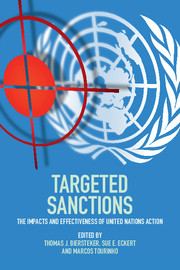Book contents
- Frontmatter
- Contents
- List of figures
- List of tables
- List of contributors
- List of abbreviations
- Introduction
- 1 Thinking about United Nations targeted sanctions
- 2 The purposes of targeted sanctions
- 3 Security Council dynamics and sanctions design
- 4 United Nations targeted sanctions and other policy tools: diplomacy, legal, use of force
- 5 The relationship between United Nations sanctions and regional sanctions regimes
- 6 Coordination of United Nations sanctions with other actors and instruments
- 7 Implementation of United Nations targeted sanctions
- 8 The impacts of United Nations targeted sanctions
- 9 The unintended consequences of United Nations targeted sanctions
- 10 The effectiveness of United Nations targeted sanctions
- 11 Institutional learning in targeting sanctions
- 12 Conclusion
- Appendix 1 List of cases and episodes
- Appendix 2 Sanctions effectiveness
- Appendix 3 TSC database codebook
- Appendix 4 Targeted Sanctions Consortium (TSC) participants
- Bibliography
- Index
3 - Security Council dynamics and sanctions design
Published online by Cambridge University Press: 05 March 2016
- Frontmatter
- Contents
- List of figures
- List of tables
- List of contributors
- List of abbreviations
- Introduction
- 1 Thinking about United Nations targeted sanctions
- 2 The purposes of targeted sanctions
- 3 Security Council dynamics and sanctions design
- 4 United Nations targeted sanctions and other policy tools: diplomacy, legal, use of force
- 5 The relationship between United Nations sanctions and regional sanctions regimes
- 6 Coordination of United Nations sanctions with other actors and instruments
- 7 Implementation of United Nations targeted sanctions
- 8 The impacts of United Nations targeted sanctions
- 9 The unintended consequences of United Nations targeted sanctions
- 10 The effectiveness of United Nations targeted sanctions
- 11 Institutional learning in targeting sanctions
- 12 Conclusion
- Appendix 1 List of cases and episodes
- Appendix 2 Sanctions effectiveness
- Appendix 3 TSC database codebook
- Appendix 4 Targeted Sanctions Consortium (TSC) participants
- Bibliography
- Index
Summary
In 2003 David Malone pointed out that the Security Council as a decision-making body had become both more operational and more professionalized after 1990, as the complexities of issues in peace and security before the United Nations increased throughout the decade. Prominent among the tools of choice for the Council in dealing with international crises – or in UN language, ‘threats to international peace and security’ – was the imposition and maintenance of economic sanctions. Andrea Charron has noted the Council's resort to targeted sanctions involved organizational learning and included the evolution of language and scope of purpose to be more consistent across cases. Thus, the sanctions regimes which had emerged by 2010, she argued, could be classified into four distinct thematic areas: ending violence, promoting democracy and human rights, dealing with terrorism, and controlling nuclear proliferation.
In the course of this evolution, Susan C. Hulton documented that the Council became more organizationally focused and cooperative as a decision-making body, and the Council's relatively frequent imposition of sanctions would appear consistent with this pattern. One of her more significant findings for the period 1992–2003 was the declining use of the veto and increased dialogue and cooperation among the Permanent Five (P5) Security Council members, and among the P5 nations and elected Member States. In particular, she notes the dramatic increase in outreach and interaction of the Council members as they receive substantive briefings on a variety of issues and an increased volume of information from the Secretariat, UN agencies, and non-governmental organizations.
More recent analysis and our own direct observations also verify increased degrees of informal dialogue, as well improvements due to the information and technological upgrading that UN staff and branches received during this time period. A number of the discrete Council sanctions votes and the general momentum to continued recourse to sanctions were aided by one of the Council's own creations, the Informal Working Group on General Issues of Sanctions, which, from 2000 to 2007, held ongoing seminars, produced various non-papers on sanctions trends and techniques, and documented both best practices and new recommendations for improving sanctions design and effectiveness.
The meetings of the Group and other Member State–sponsored seminars and reports led to increased transparency and improvements in the real substantive knowledge held by Council Members of increasingly complex sanctions and evasion techniques.
- Type
- Chapter
- Information
- Targeted SanctionsThe Impacts and Effectiveness of United Nations Action, pp. 60 - 78Publisher: Cambridge University PressPrint publication year: 2016
- 1
- Cited by



